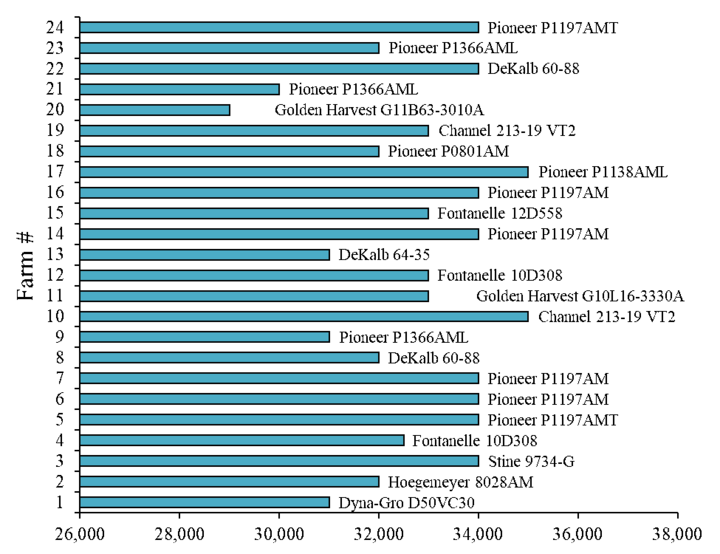Just like many decisions in life, selecting a hybrid and seeding rate for your fields each year comes with a large variety of options, lots of data to review, and ultimately a choice to make in efficiency and profitability. Competitors in this year's Testing Ag Performance Solutions (UNL-TAPS) competition just finished weighing their options and making these crucial decisions. As the choices came in, the TAPS organizers became excited for what lies ahead this year.

Ten seed dealers offered hybrid and seeding rate recommendations for the corn and soybean competitions, which included 43 corn and 14 grain sorghum hybrids (listed at taps.unl.edu). Competitors were also able to select a hybrid not listed by a seed dealer.
“To make these decisions, competitors were provided soil test results, field performance information (past competition results), and details and costs of the various hybrid options” said Daran Rudnick, Extension irrigation management specialist and TAPS team member. Some competitors chose a hybrid that they already use on their operation so they can evaluate other management practices, while others chose to experiment with a new hybrid.
Among the 16 subsurface drip irrigation (SDI) corn competition teams, 11 hybrids from six companies were selected for the inaugural year (Figure 3). The seeding rate ranged from 28,000 to 34,000 seeds per acre with the average and median being 32,625 and 33,000 seeds per acre, respectively. The most commonly selected hybrid was Pioneer 1366 AML. The SDI competition was planted May 13 at a depth of 2 inches using a six-row precision planter.

Among the 24 sprinkler corn competition teams, 15 hybrids from eight companies were selected (Figure 4). Similar to the SDI competition, seeding rate ranged from 29,000 to 35,000 seeds per acre with the average and median being 32,771 and 33,000 seeds per acre, respectively. The most commonly selected hybrid was Pioneer 1197 AM. The sprinkler competition was planted the same day with the same equipment as the SDI competition.

Competitors for the second annual sorghum competition selected 10 hybrids from six companies (Figure 5). Three contestants chose to select a non-recommended hybrid. Similar to last year, the seeding rate ranged from 70,000 to 125,000 seeds per acre with the average and median being 93,060 and 92,500 seeds per acre, respectively. Interestingly, no teams selected the same hybrid; last year, only two hybrids were selected. Due to wet conditions, the sorghum has not yet been planted.

Seed Costs
“After examining and analyzing the 2018 TAPS results, it has become evident that choosing a solid performing variety at the right price can make a considerable difference in both costs and returns,” said Matt Stockton, Extension ag economist and TAPS team member. This year’s corn selections ranged in price from $182 to $277 per bag and the sorghum hybrids ranged from $93 to $190 per bag. As the contests progress, this nearly $100 per bag difference among competitors may affect the profitability portion of the contest.
Researching the Role of Seed Selection Compared to Water and Nitrogen Management
Corn and sorghum have a diminishing response to water and nitrogen fertilizer, which means as the crop begins to reach maximum production, its growth per unit of input (water and nitrogen) begins to decrease. We call these responses “production functions.” Production functions can be very useful in determining input requirements to reach economic optimum.
“Interestingly, however, the 2017 and 2018 TAPS competition results suggest that the selected hybrids have different production functions, which means that the hybrids may also have different input requirements” said Rudnick. Therefore, to improve our understanding of the influence seed selection has on profit, efficiency, and yield as compared with water and nitrogen management decisions (i.e., amount and timing of irrigation and nitrogen fertilizer) the TAPS program is conducting several additional studies in 2019.
First, each plot in the corn SDI and sprinkler competitions will have a reference hybrid planted at a constant seeding rate adjacent to the competitor’s hybrid choices. This will provide information on the impact that timing and amount of water and nitrogen fertilizer has on yield, efficiency, and profit. Second, the top (i.e., most selected) eight corn hybrids will be planted in a separate area and subjected to incremental increases in water and nitrogen applications. This will provide information on differences in crop response to water and nitrogen fertilizer, while removing the impact of differences in timing and application methods (i.e., pre-plant, sidedress, and fertigation). Lastly, all corn and sorghum hybrids will be planted in a separate area under full water and nitrogen requirements to observe the difference in maximum production. This information will be made available to the TAPS competitors at the end of the competition.

